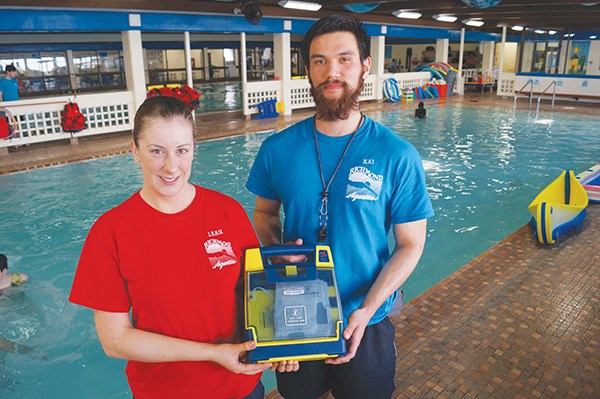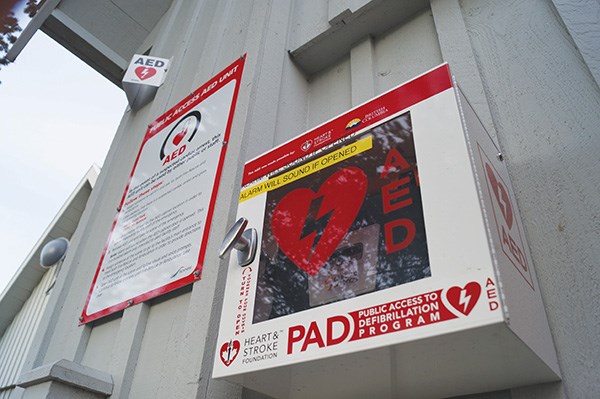It was a chilly December evening that was drawing to a close at Minoru Aquatic Centre. Lifeguard Kai Favrholdt was standing between the main pool and the smaller learning pool, and with just five minutes to closing, the 21-year-old was about to wrap up another non-eventful day at work.
9:55 p.m - Leap of faith
At 9:55 p.m. on Dec. 18, 2013, Favrholdt heard someone shouting for his attention at the shallow end of the main pool.
Over the course of the next four minutes, a harrowing moment would put Favrholdt and several other lifeguards in a time warp that saw them execute a series of manoeuvres that would eventually save a life.
The man shouting was a friend of Simon Tsang, a young senior who, for the past 16 years, frequently swam at the pool. Tsang was keeled over being held by his friend.
“As I was watching the pool I heard someone shouting at me from the shallow end. I saw there was an older gentlemen and he seemed distressed,” said Favrholdt.
The mild-mannered lifeguard saw that Tsang was having trouble breathing. Time slowed down in his mind and he assessed the situation; in a matter of seconds he determined he needed to enter the pool.
“He didn’t look good. He wasn’t breathing well and his face was a little pale. He definitely didn’t look alright,” said the Kwantlen Polytechnic University psychology student.
In fact, Tsang was having a heart attack and suffered a sudden cardiac arrest.
A sudden cardiac arrest is the failure of the heart’s electrical system. Heart attacks — where blood flow to the heart is impaired — may cause cardiac arrests. When the heart’s electrical system fails, blood circulation stops and the brain loses oxygen, resulting in unconsciousness and eventually death.
Favrholdt jumped in the pool and began abdominal thrusts. Soon, another lifeguard, Mitchell Beavis, jumped in to help pull a now unconscious Tsang out of the pool as a third lifeguard, Leah Wait, took hold from above.
Simultaneously, a fourth lifeguard was calling 9-1-1. Wait then realized Tsang wasn’t breathing.
“Right away we determined our roles. I was doing chest compressions, Leah was doing breathing,” said Favrholdt, adding it was the first time he had performed cardio pulmonary resuscitation (CPR) on a person. Beavis ran to get an automatic external defibrillator (AED) device.
9:56 p.m - Staying alive
It was now seconds after 9:56 p.m. and in the midst of a second round of compressions (30 beats then two breaths) is when Beavis applied the AED.
“Compressions are at 100 beats per minute — if you’re listening to the beats to the song Staying Alive, that’s how fast you should be doing it — so 30 compressions is very quick,” explained Wait.
The 26-year-old recreation student at Langara College said they had to dry off Tsang and make sure he wasn’t laying in any water.
“Everything was very automatic. We knew what our roles were because we practised so many times,” she said.
9:57 p.m - To the beat
It was now approaching 9:57 p.m. When the AED was turned on, it took about 10 seconds to check for a heartbeat. The devices don’t shock a patient unless there is a pulse (no matter how slight it may be). None of the lifeguards knew if the device would activate because they didn’t check for a pulse — which is now protocol in first-aid CPR as it avoids the rescuer becoming confused with their own pulse and expedites more necessary first responses like breathing and compression.
It was now 9:57 p.m. and 30 seconds.
“At this point we were hands off and the AED takes over,” said Favrholdt.
Nearly lifeless, Tsang still had a pulse.
The AED voice commanded then guided the lifeguards through the process. It alerted that a shock was advised and notified the lifeguards to activate the charge and not touch the patient.
Tsang was shocked. Favrholdt then continued compressions.
“The shock essentially reboots the heart and then you have to continue doing compressions to make sure the heart gets into a regular rhythm,” explained Wait.
9:58 p.m - Second shock
Now, just past 9:58 p.m., Favrholdt continued with another three rounds of compressions and the AED device indicated it would shock Tsang one more time, again advising Favrholdt and Wait to step away from the patient.
9:59 p.m - Simon saved
At 9:59, in an incredible and seemingly impossible four minutes, BC Ambulance Service (BCAS) paramedics arrived as the second shocks went through Tsang.
“They were here really fast,” said Wait.
Favrholdt said he passed Tsang to paramedics after 22 compressions in the fifth round.
At this point paramedics attached a much more robust AED device to Tsang’s chest. He was then taken away in an ambulance.
Tsang survived and appeared healthy and happy at a day of recognition for the lifeguards on April 4 at the aquatic facility.
“I have come to the Minoru pool several times a week for almost 16 years and my cardiac arrest happened five minutes before the pool closed. I am very lucky that it happened here and I had the help I needed right away. Thank you to everyone who helped save my life,” Tsang told his audience via a BCAS news release.
Months later, the scene is still very vivid in the lifeguards’ memories.
“It weighed on us pretty heavily,” said Wait.
It was the first time any lifeguard in Richmond had utilized an AED device. For their efforts Favrholdt, Wait and Beavis were commended by the BCAS with its Vital Link Award.
Public access to AEDs critical to rescues
AED devices are designed to be used by anyone and intended to be publicly accessible.
“They are safe and easy to use by trained and untrained individuals,” according to the Heart and Stroke Foundation of BC and Yukon (HSF) website.
The portable devices are the size of a small suitcase and have two pads that attach to a patient’s chest, read the heart rhythm and deliver electrical shocks.
They have simple instructions and the voice commands walk a user through the process. When used with CPR in the first 10 minutes of a sudden cardiac arrest the chance of surviving such an episode increases from five per cent to up to 75 per cent. For every minute that passes without a response, the probability of survival declines about seven to 10 per cent, according to studies cited by the HSF.
Each year, more than 2,000 British Columbians die from a sudden cardiac arrest. About two-thirds of victims have no history of heart problems. The HSF notes that after three to five minutes brain damage begins if the heart isn’t rebooted.
While ambulance response times in cities may be lower, the average emergency response time province-wide is nine minutes. After 12 minutes, the HSF says death is almost certain.
In understanding how critical time is, it goes without saying the foundation is on a crusade to make AED’s more prevalent and accessible throughout communities.
“We’re trying to provide more awareness about what an AED is,” said Erika Callowhill of the HSF.
Without any sort of definitive set of laws and guidelines in B.C., not to mention an under-educated public, Callowhill says AED devices could be useless in some instances, particularly if the devices are under lock and key, hidden from public.
"The system is fragmented," said Callowhill.
For instance, Richmond Centre Mall, Aberdeen Centre and Lansdowne Mall all have AEDs on site, however, they are all kept in their respective security rooms (security guards tend to double as first-aid attendants). When asked, many of the employees at the info kiosks didn’t know if an AED was on site. Some didn’t know what an AED was.
It’s highly plausible that in the time it takes to locate a mall employee, explain the situation, get a security guard to arrive with the device and then have it applied, it may be too late to save a person in cardiac arrest.
In fact, Callowhill notes, “We have had instances when an AED has been locked under a desk and someone has not made it because of that.”
According to the HSF any location that has 1,000 adults over the age of 35 present per day during normal business hours can expect at least one incident of sudden cardiac arrest every five years.
However, fear of liability, vandalism and/or unintentional ignorance are reasons why the devices are not more accessable, said Callowhill.
“There has actually been cases of vandalism and theft so many businesses keep them under lock and key,” Callowhill said, noting an AED device costs about $2,000.
Richmond Centre manager Sheila Luft said its AED placement prevents tampering.
Callowhill said HSF wants it clarified by the B.C. government that business people are not to be held liable if they have and use an AED.
Callowhill noted that AEDs could be treated in much the same way as fire extinguishers — publicly accessible but with clear penalties for misuse.
In Richmond, the five civic facilities the News visited (Seniors' Centre, Brighouse Library, Minoru Arenas, Richmond Ice Centre, Minoru Aquatic Centre) all had AEDs visible, near the front entrances, and the first staff member approached at each location was able to quickly locate it.
Callowhill said Richmond is among the more "progressive" municipalities to recognize the importance of AEDs.
Just last week, the foundation appealed to the provincial government to enact legislation similar to what came into force in Manitoba in 2013.
Manitoba’s Defibrillator Public Access Act now requires AEDs be installed in high-traffic public places, such as schools, arenas, community centres, airports and athletic facilities. The act also requires AEDs to be registered with 9-1-1 dispatchers so they can assist a responder in finding the exact location of the device. Other details are found in the Act, such as a “three minute rule,” which is used to determine how many AEDs are required at each location.
The Act requires mandated AED owners allow for member of the public to access a defibrillator and return to the victim in less than three minutes.
It assumes an average person can walk 100 meters per minute.
The act also provides clear protection from civil liability for those who use the devices in an emergency. Callowhill said the HSF, at a minimum, is asking the B.C. government to clearly define AED use under the Good Samaritan Act. Ontario has similar laws.
According to Callowhill, the foundation’s public access campaign has been met with successes as well as room for improvement. While B.C. lacks the comprehensive laws that Manitoba and most states in the U.S. have, it does have the BC Public Access to Defibrillation (PAD) Program, and in February, 2013, the province announced it would help the foundation fund and place 450 AEDs across the province within three years. The PAD Program also has an online AED registry for AED owners but it’s only voluntary, save for the above-mentioned provincially sponsored devices.
Callowhill noted a registry reminds AED owners when pads and batteries need to be changed.
Working with the province, the foundation consulted with municipalities as to where the 450 devices would be placed.
Ten devices have been placed in Richmond, mostly in parks, such as Garry Point, Minoru, King George and Garden City.
The registry, however, is still in the process of being fully developed. There is supposed to be an online tool at www.bcpadprogram.com that shows registered devices for the public, however, few show up, including none in Richmond.
A BC Ambulance Services spokesperson said it could just be a computer glitch. Callowhill confirmed the ten devices are registered with 9-1-1 in the city, but ones at civic facilities are not yet registered.




